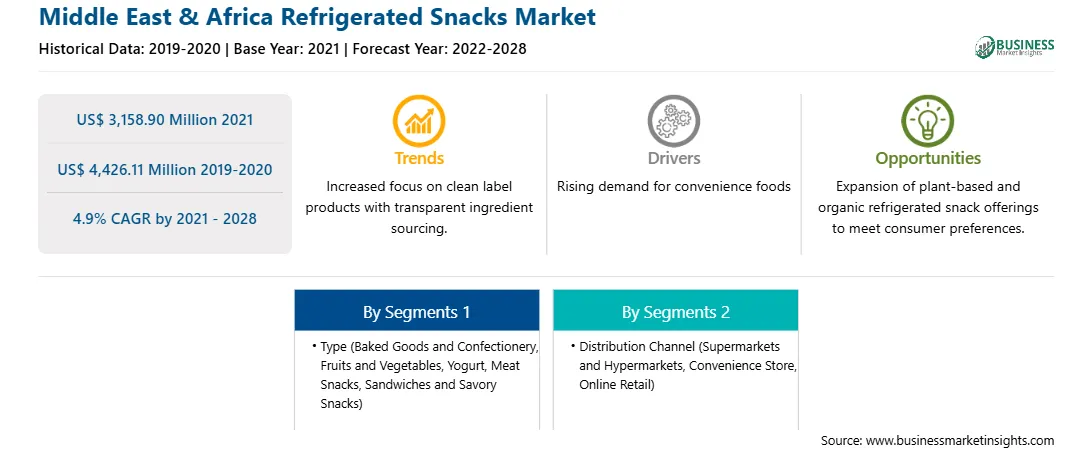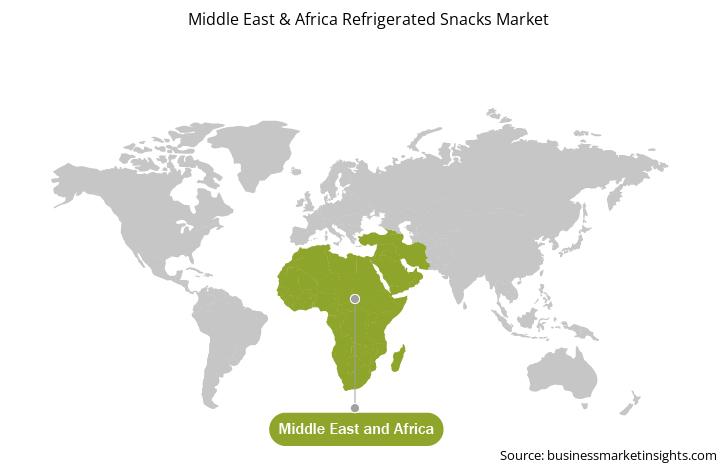The Middle East and Africa region includes countries such as South Africa, Saudi Arabia, the UAE, and the rest of the Middle East & Africa. Consumers in the Middle East and African region are increasingly more willing to try out new food trends. Owing to the strategic geographic location as well as the fast-growing population in this region, the Middle East and Africa is a distinct also thriving market along with the growth opportunities for global food & beverage companies. Most of the countries in the Middle East & Africa are heavily reliant on food imports. The GCC, in distinct, is home to a young population who own an excellent income level and a strong appetite for international convenience and organic food products. Growing demand for new foodstuff opens wide-scale opportunities in front of international food suppliers. This is further supporting the growth of refrigerated snacks in this region. New investment along with better marketing strategies have led to the capture of market share in the Middle East & Africa region. Middle Eastern countries have experienced a shift in the socio-economic condition, food eating habits, lifestyle and economic status, and health patterns in the past four decades. These countries are known for their secure financial status. This shift has occurred due to the increase in income owing to accumulated oil revenues. The studied market in the Middle East and Africa is also experiencing rapid development with the presence of countries such as Iraq, Yemen, and Iran. Refrigerated snacks are estimated to have a growing opportunity in the Middle East and Africa region owing to its rising demands from the young generation, who tend to prefer healthy and convenient snacks as a small meal.
Saudi Arabia started the highest number of COVID-19 cases in the Middle East & Africa region, followed by Turkey and the UAE. The UAE is the Middle East & Africa was the first country to report a confirmed case of COVID-19. Due to the lockdowns in the Middle East & African countries, numerous food and beverage companies remain closed, and production activities have also been halted. However, with extra precautionary measures, food manufacturers have started their operation, and mostly, they are going online to offer products. The sale of food products has been increased mainly through online retail rather than supermarkets & hypermarkets. Hence, there are opportunities for refrigerated snack manufacturers to invest in this market

Strategic insights for the Middle East & Africa Refrigerated Snacks provides data-driven analysis of the industry landscape, including current trends, key players, and regional nuances. These insights offer actionable recommendations, enabling readers to differentiate themselves from competitors by identifying untapped segments or developing unique value propositions. Leveraging data analytics, these insights help industry players anticipate the market shifts, whether investors, manufacturers, or other stakeholders. A future-oriented perspective is essential, helping stakeholders anticipate market shifts and position themselves for long-term success in this dynamic region. Ultimately, effective strategic insights empower readers to make informed decisions that drive profitability and achieve their business objectives within the market.

| Report Attribute | Details |
|---|---|
| Market size in 2021 | US$ 3,158.90 Million |
| Market Size by 2028 | US$ 4,426.11 Million |
| Global CAGR (2021 - 2028) | 4.9% |
| Historical Data | 2019-2020 |
| Forecast period | 2022-2028 |
| Segments Covered |
By Type
|
| Regions and Countries Covered | Middle East and Africa
|
| Market leaders and key company profiles |
The geographic scope of the Middle East & Africa Refrigerated Snacks refers to the specific areas in which a business operates and competes. Understanding local distinctions, such as diverse consumer preferences (e.g., demand for specific plug types or battery backup durations), varying economic conditions, and regulatory environments, is crucial for tailoring strategies to specific markets. Businesses can expand their reach by identifying underserved areas or adapting their offerings to meet local demands. A clear market focus allows for more effective resource allocation, targeted marketing campaigns, and better positioning against local competitors, ultimately driving growth in those targeted areas.

The refrigerated snacks market in MEA is expected to grow from US$ 3,158.90 million in 2021 to US$ 4,426.11 million by 2028; it is estimated to grow at a CAGR of 4.9% from 2021 to 2028. Boom in demand for convenience foods, There is a surge in demand for refrigerated snacks attributable to the rise in purchasing power along with growing consumer preference toward healthy and ready-to-eat convenience food items. Further, with the growing food &beverages industry, rise in the working population, and wider product availability through both online and offline retailing, consumers are inclining more toward convenience foods. Refrigerated snacks are readily available in retail outlets or stores and are increasingly being used as a condiment to add taste, texture, and nutrition to the food product in which they are used. Consumers are inclining over fresher and less processed products that are equally healthy and nutritious and can be directly consumed. With the expansion of the distribution network, convenience foods have gained a shelf in the supermarkets & retail outlets. Additionally, the change in working demographics along with busy lifestyles is among the other factors promoting the demand for convenience food items. With the increase in the demand for convenience food items, the need for refrigerated snacks is set to propel. These snacks offered ease of use, easy to carry in a small space and provide nutrients, due to which some people prefer to have it rather than a proper meal.
In terms of type, the fruits and vegetables segment accounted for the largest share of the MEA refrigerated snacks market in 2020. In terms of distribution channel, the supermarkets and hypermarkets segment held a larger market share of the refrigerated snacks market in 2020.
A few major primary and secondary sources referred to for preparing this report on the refrigerated snacks market in MEA are company websites, annual reports, financial reports, national government documents, and statistical database, among others. Major companies listed in the report are Danone S.A.; General Mills Inc.; Hormel Foods Corporation; Mars Incorporated; Mondelez International, Inc.; Nestle S.A; PepsiCo; The Kraft Heinz Company; among others.
The Middle East & Africa Refrigerated Snacks Market is valued at US$ 3,158.90 Million in 2021, it is projected to reach US$ 4,426.11 Million by 2028.
As per our report Middle East & Africa Refrigerated Snacks Market, the market size is valued at US$ 3,158.90 Million in 2021, projecting it to reach US$ 4,426.11 Million by 2028. This translates to a CAGR of approximately 4.9% during the forecast period.
The Middle East & Africa Refrigerated Snacks Market report typically cover these key segments-
The historic period, base year, and forecast period can vary slightly depending on the specific market research report. However, for the Middle East & Africa Refrigerated Snacks Market report:
The Middle East & Africa Refrigerated Snacks Market is populated by several key players, each contributing to its growth and innovation. Some of the major players include:
The Middle East & Africa Refrigerated Snacks Market report is valuable for diverse stakeholders, including:
Essentially, anyone involved in or considering involvement in the Middle East & Africa Refrigerated Snacks Market value chain can benefit from the information contained in a comprehensive market report.